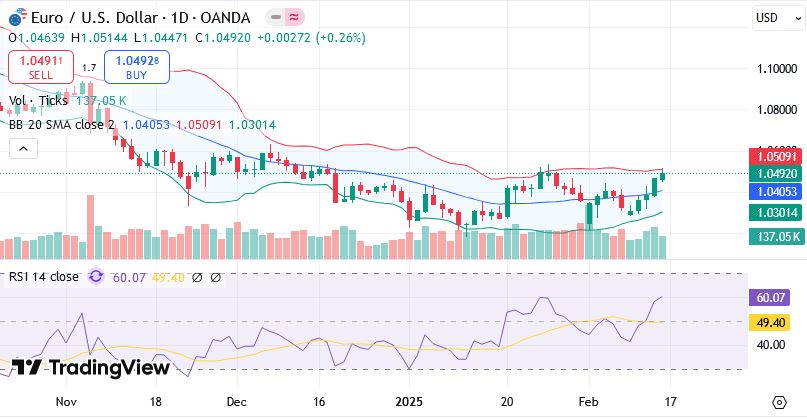U.S. Dollar Faces Downward Pressure
The U.S. dollar has been experiencing sustained weakness, with the dollar index falling for a fourth consecutive day on Friday. This decline comes amid a combination of easing tariff concerns, signs of economic slowdown in the U.S., and optimism surrounding geopolitical developments, particularly in Ukraine. As traders assess these factors, the dollar’s outlook for the coming week appears increasingly bearish, with key technical levels under pressure.
Economic Slowdown Weighs on the Dollar
One of the primary drivers behind the dollar’s recent weakness is growing concern over U.S. economic growth. A disappointing retail sales report, which showed the largest drop in consumer spending in nearly two years, has raised fears of a slowdown in the broader economy. In response to the data, Treasury yields tumbled, with the 10-year yield falling to 4.45%, reversing the gains seen since January’s robust payroll report. This dip in yields suggests investors are scaling back expectations for continued economic strength, a trend that typically undermines the U.S. dollar.
As investors digest these signs of slower growth, the dollar’s safe-haven appeal is being tested. While the U.S. remains the world’s largest economy, weaker economic data may reduce the dollar’s attractiveness relative to other currencies, particularly in the face of improving conditions elsewhere.
According to Reuters “The dollar index also fell to a nine-week low after data showed that retail sales fell more than expected in January, leading traders to raise bets that the Federal Reserve may cut rates two times this year.”
Easing Tariff Concerns and Global Sentiment Shifting in Favor of Risk Assets
The easing of tariff concerns also contributed to the dollar’s downward pressure. With the European Commission signaling a firm and immediate response to any tariff increases, the fears of escalating trade tensions that had previously supported the dollar’s safe-haven status have receded. This shift in sentiment has encouraged risk-on behavior, with investors moving away from the dollar in favor of riskier assets, including the euro and British pound.
Ukraine Peace Talks Boosts Euro Sentiment
A key factor contributing to the weakening of the dollar has been optimism surrounding the potential for peace talks in Ukraine. Ukrainian President Volodymyr Zelenskiy expressed a willingness to engage in discussions with Russian President Vladimir Putin, provided there is an agreed-upon plan with U.S. President Donald Trump and European leaders. This development has helped reduce geopolitical risk, further diminishing the dollar’s role as a safe haven.
The euro has been one of the major beneficiaries of this shift, with EUR/USD rising as high as 1.0514. The currency pair found momentum, bolstered by optimism over the potential resolution of the conflict in Ukraine. However, resistance near the year-to-date high of 1.0532, compounded by large option expiraries and upper Bollinger Band resistance, may limit further significant moves higher in the short term. Should this upward momentum persist, though, the dollar could face additional selling pressure against the euro.

British Pound Tests New Highs Amid Dollar Weakness
The British pound has also surged in response to the dollar’s weakness, with GBP/USD reaching a new year-to-date high of 1.2631. The pound has been benefiting from a favorable technical setup and a shift in sentiment, with momentum currently working in the currency’s favor. Traders are now eyeing a series of important U.K. economic reports, including employment data and inflation readings, which could further support the pound’s advance.
Additionally, comments from British Prime Minister Keir Starmer regarding potential discussions with U.S. President Trump have spurred optimism, adding to the favorable backdrop for the pound. As long as the dollar remains under pressure, GBP/USD could continue to test higher levels.
Technical Outlook: USD/CHF and USD/JPY Show Bearish Trends
On the technical front, the U.S. dollar’s weakness is apparent across multiple pairs. USD/CHF dropped below its 55-day moving average, marking a new year-to-date low of 0.8969. This development points to a continued downtrend for the dollar against the Swiss franc.
Similarly, USD/JPY has been pressured by falling Treasury yields, though downward momentum has stalled just before the 152 level, where options are stationed. The pair’s bearish trend remains intact, but any significant moves lower may be limited by support at the 200-day moving average (DMA) at 152.74. Resistance at the 100-DMA (153.35) and 21-DMA (154.16) suggests the pair could remain range-bound in the short term.
The Impact of Falling Treasury Yields
The drop in Treasury yields, especially the 10-year yield, has contributed to narrowing the yield differential between the U.S. and other major economies. This reduces the appeal of the U.S. dollar for yield-seeking investors, further undercutting its strength. With yields on the decline and U.S. economic growth concerns mounting, the outlook for the dollar in the week ahead remains weak.
Conclusion: A Bearish Outlook for the Dollar
In summary, the U.S. dollar faces continued headwinds as economic growth concerns weigh on investor sentiment and geopolitical risk recedes. With weakening U.S. economic data, particularly retail sales, and easing tariff worries, the dollar is likely to remain under pressure in the coming week. The euro and British pound are poised to benefit from these developments, and the dollar may struggle to regain its footing without a significant change in economic data or market sentiment.
Traders will be closely watching further U.S. economic reports, especially retail sales, inflation, and employment data, as any negative surprises could deepen the dollar’s downtrend. However, with geopolitical optimism surrounding Ukraine and the European Commission’s stance on tariffs, risk sentiment may continue to favor the euro and pound over the dollar in the near term.
